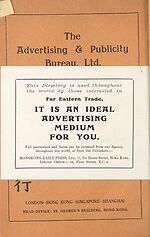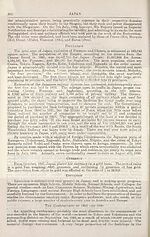1933
(317) [Page 261]
Download files
Complete book:
Individual page:
Thumbnail gallery: Grid view | List view
![(317) [Page 261] -](https://deriv.nls.uk/dcn17/2036/7843/203678434.17.jpg)
JAPAN
Constitution and Government
The government of the Japanese Empire was anciently, in theory at least, that
of an absolute monarchy, but the real administrative and executive power was in the
hands of the Shogun and his clansmen. In the year 1868 the Imperialist party over¬
threw, after a short war, the power of the Shogun, together witli that of the Daimibs,
•or feudal nobles, who, On the 25th June, 1869, resigned their lands, revenues, and
retainers to the Mikado, by whom they were permitted to retain one-tenth of their
-original incomes, but ordered to reside in the capital in future. The sovereign is known
as the Emperor. The word “Mikado” is only one of many honorific titles and has
never been in general use among the Japanese.
Hirohito, the reigning monarch, succeeded to the throne in December. 1927, arid the
coronation ceremonies were performed in Kyoto in November, 1928. His Majesty is
•thirty-one years of age and is, according to Japanese chronology, partly mythical,
!he 124th of an unbroken dynasty, founded 660 B.c.
The power of the Mikado was formerly absolute, but its exercise was controlled to
some extent by custom and public opinion. The Emperor Mutsuhito, posthumpusly
and ordinarily known as the Emperor Meiji in 1875, when the Senate and Supreme
Judicial Tribunal were founded, solemnly declared his earnest desire to have a con¬
stitutional system of government. The Mikado has long been regarded as the spiritual
as well as the temporal head of the Empire, but, although the Shinto faith is held
to be a form of national religion, the Emperor does not interfere in religious matters,
and all religions are tolerated in Japan. The Ecclesiastical Department was in 1877
reduced, to a simple bureau under the control of the Minister of the Interior. The
Emperor acts through an Executive Ministry divided into eleven department^,
— Gwaimu Sho (Foreign Affairs), Naimu Sho (Interior), Okura Sho (Finance), Kaigun
Sho (Navy), Rikugun Sho (Army), Shiho Sho (Justice), Mombu Sho (Education), Norih
Sho ('Agriculture and Forestry), Shoko Sho (Commerce and Industry), Teishin Sho (Com¬
munications) Takumusho (Overseas Affairs) and Testudo-sho (Railways). In 1888 a Privy
Council, modelled on that of Great Britain, was constituted. The new Constitution,
promised by the Mikado, was proclaimed on the llth February, 1889, and in July,
1890, the first Parliament was elected; it met on th,e 2gith November. The Parliament¬
ary system is bicameral, the House of Peers and the House of Representatives con¬
stituting the Imperial Diet.
The Empire is divided for administrative purposes into three Em, or u rban prefectures
(Tokyo, Kyoto, and Osaka), and 43 Ken, or prefectures, including the Loochoo Islands,
which have been converted into a ken and named Okinawa. The island of Yezo is under
a separate administration, called Hokkaido-cho. Chosen or COrea, which was annexed
by Japan in 1910, Formosa, and the Kwantung Province of Manchuria are governed as
colonies with a Governor General, or, in the case Of Kwantung, a Governor, under the
general supervision of the Ministry of Overseas Affairs. Kwantung Province was
originally leased by Russia from China, the lease being taken over by Japan as a result of
the Russo-Japanese war. The fu and ken are governed by prefects, who are all of
equal rank, are under the control of the Ministry of the Interior and have limited
powers, being required to submit every matter, unless there is a precedent for it, to
the Minister of the Interior. Nor have they any concern in judicial proceedings, which
come under the cognizance of the 51 local Courts, and the seven Supreme Courts at
Tokyo, Osaka, Nagoya, Hiroshima, Nagasaki, Miyagi, and Sapporo, over which the
Daishin-In presides at Tokyo.
Previous to the last change of Government, which restored the ancient Imperial
■regime, the administrative authority rested with the Shogun (Military Commander),
whom foreigners were at first led to recognise as the temporal sovereign, and with whom
they negotiated treaties of peace and commerce. The Shogunate was founded in
1184 by Yoritomo, a general of great valour and ability, and was continued through
several dynasties until 1868, when the Tokugawa family were dispossessed of the
.usurped authority. Under the Shogun 300 or more Daimios (feudal princes) shared
Constitution and Government
The government of the Japanese Empire was anciently, in theory at least, that
of an absolute monarchy, but the real administrative and executive power was in the
hands of the Shogun and his clansmen. In the year 1868 the Imperialist party over¬
threw, after a short war, the power of the Shogun, together witli that of the Daimibs,
•or feudal nobles, who, On the 25th June, 1869, resigned their lands, revenues, and
retainers to the Mikado, by whom they were permitted to retain one-tenth of their
-original incomes, but ordered to reside in the capital in future. The sovereign is known
as the Emperor. The word “Mikado” is only one of many honorific titles and has
never been in general use among the Japanese.
Hirohito, the reigning monarch, succeeded to the throne in December. 1927, arid the
coronation ceremonies were performed in Kyoto in November, 1928. His Majesty is
•thirty-one years of age and is, according to Japanese chronology, partly mythical,
!he 124th of an unbroken dynasty, founded 660 B.c.
The power of the Mikado was formerly absolute, but its exercise was controlled to
some extent by custom and public opinion. The Emperor Mutsuhito, posthumpusly
and ordinarily known as the Emperor Meiji in 1875, when the Senate and Supreme
Judicial Tribunal were founded, solemnly declared his earnest desire to have a con¬
stitutional system of government. The Mikado has long been regarded as the spiritual
as well as the temporal head of the Empire, but, although the Shinto faith is held
to be a form of national religion, the Emperor does not interfere in religious matters,
and all religions are tolerated in Japan. The Ecclesiastical Department was in 1877
reduced, to a simple bureau under the control of the Minister of the Interior. The
Emperor acts through an Executive Ministry divided into eleven department^,
— Gwaimu Sho (Foreign Affairs), Naimu Sho (Interior), Okura Sho (Finance), Kaigun
Sho (Navy), Rikugun Sho (Army), Shiho Sho (Justice), Mombu Sho (Education), Norih
Sho ('Agriculture and Forestry), Shoko Sho (Commerce and Industry), Teishin Sho (Com¬
munications) Takumusho (Overseas Affairs) and Testudo-sho (Railways). In 1888 a Privy
Council, modelled on that of Great Britain, was constituted. The new Constitution,
promised by the Mikado, was proclaimed on the llth February, 1889, and in July,
1890, the first Parliament was elected; it met on th,e 2gith November. The Parliament¬
ary system is bicameral, the House of Peers and the House of Representatives con¬
stituting the Imperial Diet.
The Empire is divided for administrative purposes into three Em, or u rban prefectures
(Tokyo, Kyoto, and Osaka), and 43 Ken, or prefectures, including the Loochoo Islands,
which have been converted into a ken and named Okinawa. The island of Yezo is under
a separate administration, called Hokkaido-cho. Chosen or COrea, which was annexed
by Japan in 1910, Formosa, and the Kwantung Province of Manchuria are governed as
colonies with a Governor General, or, in the case Of Kwantung, a Governor, under the
general supervision of the Ministry of Overseas Affairs. Kwantung Province was
originally leased by Russia from China, the lease being taken over by Japan as a result of
the Russo-Japanese war. The fu and ken are governed by prefects, who are all of
equal rank, are under the control of the Ministry of the Interior and have limited
powers, being required to submit every matter, unless there is a precedent for it, to
the Minister of the Interior. Nor have they any concern in judicial proceedings, which
come under the cognizance of the 51 local Courts, and the seven Supreme Courts at
Tokyo, Osaka, Nagoya, Hiroshima, Nagasaki, Miyagi, and Sapporo, over which the
Daishin-In presides at Tokyo.
Previous to the last change of Government, which restored the ancient Imperial
■regime, the administrative authority rested with the Shogun (Military Commander),
whom foreigners were at first led to recognise as the temporal sovereign, and with whom
they negotiated treaties of peace and commerce. The Shogunate was founded in
1184 by Yoritomo, a general of great valour and ability, and was continued through
several dynasties until 1868, when the Tokugawa family were dispossessed of the
.usurped authority. Under the Shogun 300 or more Daimios (feudal princes) shared
Set display mode to:
![]() Universal Viewer |
Universal Viewer | ![]() Mirador |
Large image | Transcription
Mirador |
Large image | Transcription
Images and transcriptions on this page, including medium image downloads, may be used under the Creative Commons Attribution 4.0 International Licence unless otherwise stated. ![]()
| Asian directories and chronicles > 1933 > (317) [Page 261] |
|---|
| Permanent URL | https://digital.nls.uk/203678432 |
|---|
| Attribution and copyright: |
|
|---|---|
| Description | Volumes from the Asian 'Directory and Chronicle' series covering 1917-1941, but missing 1919 and 1923. Compiled annually from a multiplicity of local sources and research. They provide listings of each country's active corporations, foreign residents and government agencies of all nationalities for that year, together with their addresses. Content includes: various treaties; coverage of conflicts; currencies and taxes; consular fees; weights and measures; public holidays; festivals and traditions. A source of information for both Western states and communities of foreigners living in Asia. Published by Hongkong Daily Press. |
|---|---|
| Shelfmark | H3.86.1303 |
| Additional NLS resources: |

